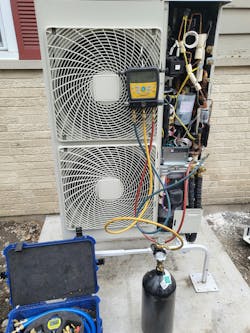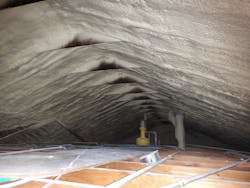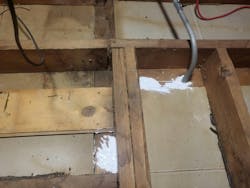Two years ago, I replaced both my drastically oversized HVAC equipment and my antiquated graduated-trunk duct system. It was time for a complete overhaul. My goal was to improve the indoor air quality (IAQ) of my home while also increasing my family’s comfort. Another goal was to convert my gas heating system to an all-electric one, which included a cold climate heat pump. I wanted to experience a heat pump firsthand before offering them to my customers.
I am guilty of installing the previously oversized system, a Trane 100,000 Btu 95% efficient furnace, and a three-ton 18-SEER condenser. I did not know residential HVAC design when I installed the system. So, I did what most contractors do: replaced the system with like-for-like sizing.
The duct work was original to my 1960s-era home. It was beautifully hand-crafted, featuring rounded offsets, Goldberg fittings (a 90° fitting that rotates its direction), and even handmade boots. Sheet metal fabrication is a lost art, and the craftsman who installed my duct system is most likely dead and gone. I almost felt guilty removing this man’s artwork from my basement ceiling.
The Design
I struggle with perfectionism, which causes my home projects to move very slowly. I must have changed the duct design five times before I settled on the final layout. My basement has a seven-foot ceiling height with a steel beam running down the length of the home. One of my goals was to create a duct system that would allow for more headroom, reducing the chances of banging my head every time I went downstairs. I decided on a U-shaped trunk and branch duct system that would wrap around the perimeter.
The load calculation showed a 48,809 Btu heat loss and a 24,000 Btu heat gain. This included 150 CFM of outside air for ventilation.
The whole goal of an inverter is to experience the full range of modulation while allowing the system to run as long as possible.
I ended up installing a three-ton Daikin Skyair heat pump (See photo 1). This was my first mistake. The cooling capacity was oversized by 12,000 Btus. That might not sound like a big deal if you only consider sensible capacity, but when you look at the latent load, it can be a big problem. Short cycling equipment is the enemy of dehumidification.
I installed the three-ton because I was scared. I feared I’d freeze my family in the middle of a Midwest polar vortex. Besides, everyone knows that you can’t oversize an inverter, right?
WRONG!
Attending the Air Conditioning Contractors of America (ACCA) residential design class taught me to trust the math and never use a safety factor. If only I had listened. An oversized inverter is the most expensive single-stage machine you can buy. In my case, the system operated at the correct total fan airflow, but it is more common than not to have a system with low airflow.
Running a system with low fan airflow reduces its efficiency. That oversized 20 SEER you installed with low fan airflow might operate as an 18 SEER or much worse if you take the system temperatures into account. The whole goal of an inverter is to experience the full range of modulation while allowing the system to run as long as possible.
Shifting the Load
I decided to air-seal my home after completing the new heat pump and duct work installation. This was my second mistake.
I should have tightened the envelope of my house before installing the new heat pump. Things got even worse when I encapsulated my attic with closed-cell foam (See photo 2). The new system is now grossly oversized. In hindsight, I realized my steps were out of order, and this valuable lesson would impact my future process.
I needed help, so I called Roman Baugh, a friend and former technical service manager at Daikin North America. I was lucky to have been able to pick his brain and learn the subtle nuances of the system.
Roman suggested I order a new capacity plug for the air handler. Installing a 1.5-ton capacity plug would limit the system’s capacity and allow it to run as a unit half its size.
I lucked out. Most residential systems don’t provide the ability to reprogram their size. If I had installed a different brand, the only fix would have been to replace the oversized equipment or install a whole house dehumidifier.
Providing Ventilation
The original plan for ventilation was to connect a seven-inch outside air duct directly to the return. With this type of ventilation, it is essential to tie in fresh air in an area that will promote good mixing. If the conditions are right, condensation can occur inside the return duct. Understanding this principle led me to explore another ventilation strategy.
The existing bath fans were not ducted to the outdoors. Leaving the bathroom exhaust as is would create moisture issues in my attic. So, I removed the bath fans and installed a Panasonic cold climate energy recovery ventilator (ERV).
I designed the ERV controls and ducting to be isolated from the heating and cooling system. The returns are in each of the four bathrooms, and fresh air supplies in the bedrooms. The ERV runs non-stop to provide constant ventilation and I terminated the fresh air intake high on the outside wall. This location was essential to minimize the risk of introducing dust and rodents into the duct.
After tightening the building’s shell and installing an ERV, I noticed that I could maintain healthy humidity levels during the winter months without needing a whole-house humidifier. Air with high moisture content is lighter than dry air and will naturally rise to the top of a structure.
If a structure leaks air through the ceiling, that humid air will leak out, causing low relative humidity in the living space. I stopped the humid air from escaping my home by encapsulating the attic. Using an ERV for bathroom exhaust helps repurpose the moisture created when running a shower while eliminating the need for a humidifier.
Problems With Filtration
In the Midwest, it is common to see individual returns installed in nearly every room of a house. I removed all the ducted returns and converted the system to a central basement return. You must be extremely cautious when installing returns in a basement because you can create draft issues with gas-fired appliances. Radon is another concern and can enter the basement through drain tiles and cracks in the concrete slab.
I have an open staircase to the basement, which allows return air to flow back to the air handler. I have noticed the dust doesn’t stay entrained in the air long enough to make it back to the MERV 16 filter. Another problem is that the 1.5-ton heat pump doesn’t move as much air as the old 100,000 btu furnace and three-ton air conditioning unit. Moving less air means fewer air changes per hour and less air passing through the filter. It is possible the air quality would have improved if I had kept the individual room returns, although the amount of air being filtered would remain the same.
I temporarily improved my air quality by assembling a Comparetto cube, which is five 20-in. x 20-in. x 2-in. filters taped together with a box fan. The downside of this type of filtration device is that it is big, ugly, and loud.
In the long term, I plan to install a duct system in the attic tied into an air handler with another MERV 16 filter. The idea is to constantly run the variable-speed fan on the air handler to capture any dust before it falls out of the air. I plan to use a Haven IAQ monitor in the return duct system to increase the blower speed when the particle count is high. Time will tell if my plan improves my home’s indoor air quality.
If You Don’t Test, Then You Guess
Replacing my system has been a great learning experience. I have monitored system run times, the room and house pressures, and the indoor air quality. In the past, I have made prescriptive recommendations for my residential customers without understanding their homes.
It is easy to overlook important details that can impact the comfort of a home, even when testing and using data to make decisions. Imagine designing and commissioning a High-Performance HVAC™ system without testing the results. The odds of success would be low, and you might have better luck playing the lottery. Using numbers and data is not an option; it is a necessity if your goal is to install a safe, comfortable, and efficient system.
Adam Mufich serves the HVAC industry as a content developer and instructor for National Comfort Institute, Inc. (NCI). NCI specializes in training that focuses on improving, measuring, and verifying HVAC and Building Performance.
If you’re an HVAC contractor or technician interested in learning more about air sealing benefits, contact Adam at ncilink.com/ContactMe. NCI’s website www.nationalcomfortinstitute.com is full of free information to help you improve your professionalism and strengthen your company.
About the Author
Adam Mufich
content developer and instructor
Adam Mufich serves the HVAC industry as content developer and instructor for National Comfort Institute, Inc. (NCI). NCI specializes in training that focuses on improving, measuring, and verifying HVAC and Building Performance. Find them at www.nationalcomfortinstitute.com.



